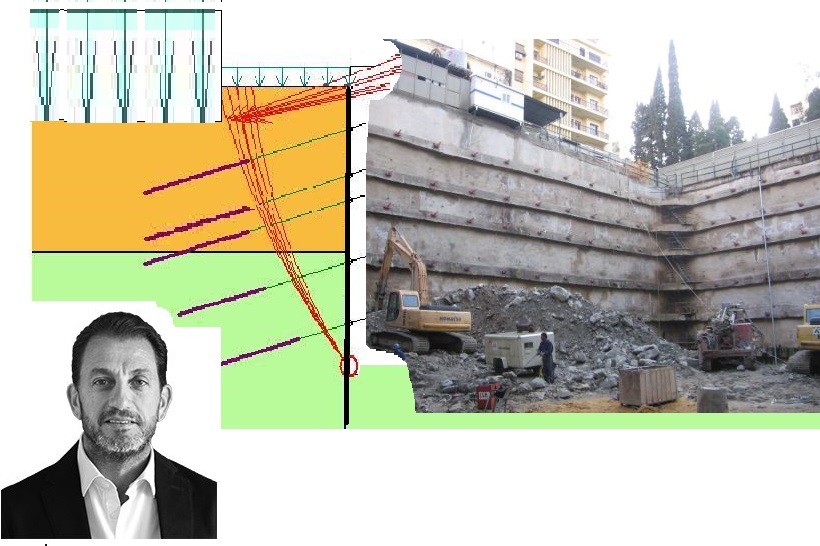![Decompose, Recompose: Useful approaches for the design of geotechnical structures (in French) {"category":"webinar","subjects":["Soil Structure Interaction", "Foundation Design/Construction", "Numerical and Constitutive Modelling"],"number":"CFMS-02","instructors":["Bruno Simon"]}](/asset-v1:ISSMGE+CFMS-02+2025+type@asset+block@webinar2.png)
- ISSMGE
- {"category":"webinar","subjects":["Soil Structure Interaction", "Foundation Design/Construction", "Numerical and Constitutive Modelling"],"number":"CFMS-02","instructors":["Bruno Simon"]}
- Starts:


This course includes four lectures, by Jean-Louis Briaud (USA), Zenon Medina-Cetina (USA) and Marco Uzielli (Italy), An Bing Huang (Taiwan) and Marc Ballouz (Lebanon). The titles and the summaries are as follows:
Bridge scour depth prediction and levee topping erosion, by Jean-Louis Briaud (96 min)
Erosion of soils related to scour and measurement of erodibility are illustrated and analysed from the Woodrow Wilson Bridge case history. Levee overtopping is then introduced with development of design charts. Third, learned lessons from two disasters US case histories related to overtopping are formulated.
Risk and Geotechnical Engineering, by Zenon Medina-Cetina (USA) and Marco Uzielli (Italy) (100 min)
First, the basics and applications of Risk Assessment to GE are introduced. Then, an overview of the principles, methods and implications of framing GE practice within a Quantitative Risk Assessment is given. The proposed approach is based on common established practice. The homogenization of technical terms of Risk, a quantitative framework reference of Risk and corresponding Risk estimation methods are discussed. Illustrative case studies of various degrees of complexity are presented.
Landslide risk mitigations with a special emphasis on observation with fiber optic sensors, by An Bing Huang (34 min)
The fiber optic sensors technique (FOST) is first introduced. How this technique can be performed is then explained in case of slopes subjected to rainfall. The study of illustrative case history highlights the benefits of FOST and observational method to mitigate landslides.
Challenges in Shoring Deep Excavations in Urban Areas, by Marc Ballouz (74 min)
Basics related to limit equilibrium methods for the study of deep excavation stability are introduced. Focus is made on the mechanism of reinforcing effect when rigid inclusions are used. Focus is given on the role of water flow under shoring excavation. Some illustrative case histories show how the challenging situations can be overcome.
![Decompose, Recompose: Useful approaches for the design of geotechnical structures (in French) {"category":"webinar","subjects":["Soil Structure Interaction", "Foundation Design/Construction", "Numerical and Constitutive Modelling"],"number":"CFMS-02","instructors":["Bruno Simon"]}](/asset-v1:ISSMGE+CFMS-02+2025+type@asset+block@webinar2.png)
![Zelazny Most Copper Tailings Depository Numerical Analysis of Deep Vertical Shafts (First Tschebotarioff Lecture) {"category":"honour_lecture","subjects":["Mining", "Numerical and Constitutive Modelling"],"number":"HTL101","instructors":["Michele Jamiolkowski"]}](/asset-v1:ISSMGE+HTL101+2014+type@asset+block@htl101.jpg)
![Modelling and Testing (Bishop Lecture - 19th ICSMGE) {"category":"honour_lecture","subjects":["Laboratory Testing", "Numerical and Constitutive Modelling"],"number":"ICSMGE102","instructors":["David Muir Wood"]}](/asset-v1:ISSMGE+ICSMGE102+2017+type@asset+block@bishop-lecture.jpg)
![Susceptibility Assessment of Rainfall Induced Landslides: A Case Study of the Debris Flow on July 27, 2011 at Umyeonsan (Mt.), Seoul, Korea (Urban Geohazard Special Lecture - 19th ICSMGE) {"category":"honour_lecture","subjects":["Landslides"],"number":"ICSMGE19109","instructors":["Myoung Mo Kim"]}](/asset-v1:ISSMGE+ICSMGE19109+2017+type@asset+block@urban-geohazard-lecture.jpg)
![Reliability-Based Approach for Robust Geotechnical Design (Suzanne Lacasse Lecture - 19th ICSMGE) {"category":"honour_lecture","subjects":["Risk and Reliability"],"number":"ICSMGE19116","instructors":["Farrokh Nadim"]}](/asset-v1:ISSMGE+ICSMGE19116+2017+type@asset+block@lacasse-lecture.jpg)
![Landslides and Mitigations {"category":"course","subjects":["Landslides"],"number":"LM101","instructors":["Charles Wang Wai Ng","Luciano Picarelli","Scott McDougall","Bak Kong Low "]}](/asset-v1:ISSMGE+LM101+2021+type@asset+block@intro.jpg)
![Landslide Runout Analysis Current Practice and Challenges {"category":"webinar","subjects":["Landslides"],"number":"LS101","instructors":["Scott McDougall"]}](/asset-v1:ISSMGE+LS101+2019+type@asset+block@landslide-runout-analysis.jpg)
![The Classification of Landslides in Soils in a Mechanical Perspective {"category":"short_edu","subjects":["Landslides"],"number":"LS102","instructors":["Luciano Picarelli"]}](/asset-v1:ISSMGE+LS102+2020+type@asset+block@covatta-earthflow-1996.png)
![Numerical modelling in Geomechanics {"category":"webinar","subjects":["Numerical and Constitutive Modelling"],"number":"TC103-03","instructors":["T. Noda","H. Schweigher","F. Nicot","J. McCartney"]}](/asset-v1:ISSMGE+NM101+2022+type@asset+block@numerical-modelling-geomechanics.jpg)
![An Introduction to Numerical Modelling in Geotechnical Engineering {"category":"webinar","subjects":["Numerical and Constitutive Modelling"],"number":"NSM101","instructors":["Helmut F. Schweiger"]}](/asset-v1:ISSMGE+NSM101+2017+type@asset+block@Schweiger-Intro.jpg)
![Risk Analysis and Machine Learning {"category":"honour_lecture","subjects":["Machine Learning and Big Data","Risk Assessment and Management","Risk and Reliability"],"number":"TC304-APSSRA-02","instructors":["J. Ching","P. Samui","L. Zhang"]}](/asset-v1:ISSMGE+RAML101+2022+type@asset+block@machine-learning.jpg)
![Introduction to Slope Engineering {"category":"course","subjects":["Numerical and Constitutive Modelling","Soil Mechanics","Slope Stability"],"number":"GEE2020-1","instructors":["Wu Shunchuan"]}](/asset-v1:ISSMGE+SE101+2023+type@asset+block@intro-slide.jpg)
![From Discrete to Continuum: Multiscale Approach of Failure in Geomaterials {"category":"webinar","subjects":["Numerical and Constitutive Modelling"],"number":"TC103-01","instructors":["Francois Nicot"]}](/asset-v1:ISSMGE+TC103-01+2021+type@asset+block@Nicot-cover.jpg)
![Numerical Simulations on Energy Piles {"category":"webinar","subjects":["Numerical and Constitutive Modelling"],"number":"TC103-02","instructors":["John McCartney"]}](/asset-v1:ISSMGE+TC103-02+2021+type@asset+block@Screenshot_2024-05-14_143023.png)
![Performance assessment of soils and structures by numerical analysis {"category":"webinar","subjects":["Numerical and Constitutive Modelling"],"number":"TC103-03","instructors":["Toshihiro NODA"]}](/asset-v1:ISSMGE+TC103-03+2021+type@asset+block@cover.jpg)
![Numerical Simulation of Soft Soil Improvement Using Prefabricated Vertical Drains and Preloading {"category":"webinar","subjects":["Numerical and Constitutive Modelling"],"number":"TC103-04","instructors":["Ali Parsa-Pajouh"]}](/asset-v1:ISSMGE+TC103-04+2025+type@asset+block@photo.png)
![Space-Time Finite Element Methods (ST/FEM) for Transient Problems in Geomechanics {"category":"webinar","subjects":["Numerical and Constitutive Modelling"],"number":"TC103-05","instructors":["Vikas Sharma"]}](/asset-v1:ISSMGE+TC103-05+2025+type@asset+block@lecture-photo.png)
![TC211 4th Louis Menard Lecture: Ground Improvement for Heavily Loaded Structures and Experiences from Challenging Projects {"category":"honour_lecture","subjects":["Deep Excavations","Deep Foundations"],"number":"TC211-13","instructors":["Michal Topolnicki"]}](/asset-v1:ISSMGE+TC211-13+2025+type@asset+block@Technical_Photo.jpg)
![Field-scale Implementation of EICP and What Comes Next {"category":"webinar","subjects":["Deep Excavations", "Deep Foundations"],"number":"TC211-14","instructors":["Kimberly Martin"]}](/asset-v1:ISSMGE+TC211-14+2025+type@asset+block@Picture1.png)
![Foundations {"category":"course","subjects":["Instrumentation","Deep Foundations","In-situ Testing","Geothermal","Energy Geotechnics","Offshore Geotechnics"],"number":"VU-EE","instructors":["F Rausche","H Poulos","L Laloui","MJ Cassidy"]}](/asset-v1:ISSMGE+TC212-001+2016+type@asset+block@Laloui-Thermo-Active-Foundations.jpg)
![Collapse of Fujinuma Dam by the 2011 Great East Japan Earthquake and its reconstruction {"category":"webinar","subjects":["Earth Retaining Structures"],"number":"TC302-01","instructors":["Fumio Tatsuoka", "Antoine Duttine"]}](/asset-v1:ISSMGE+TC302-01+2021+type@asset+block@tc302-fujinuma.jpg)